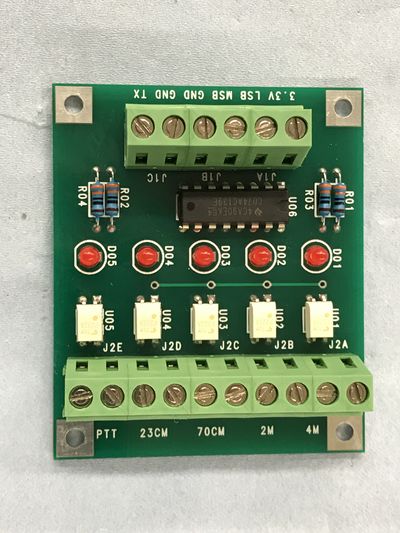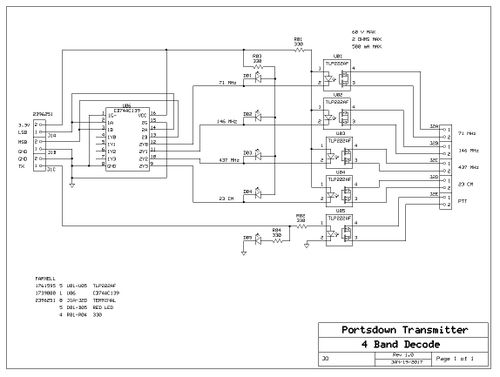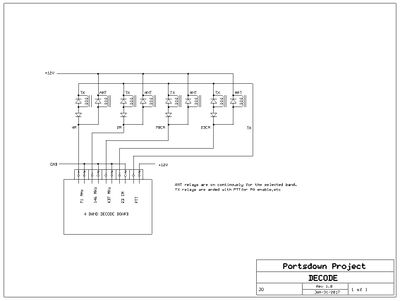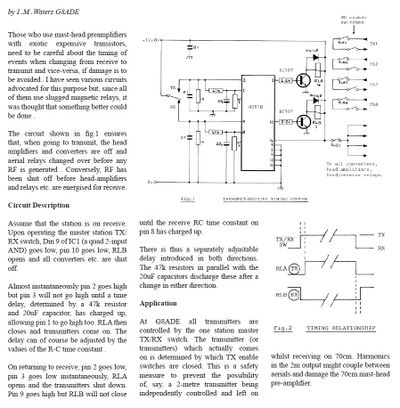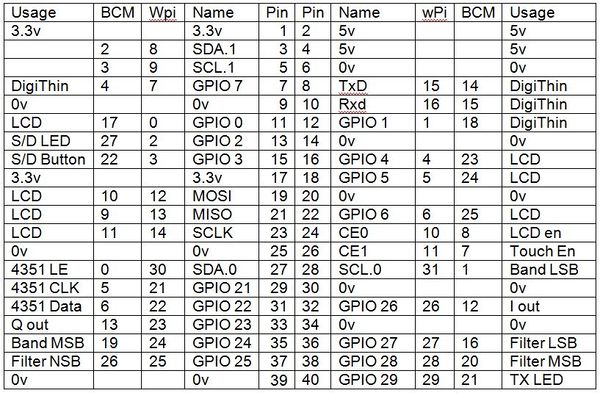Difference between revisions of "PTT and band switching"
(Created page with "In order to make the Portsdown transmitter integrated with transmit and receive systems, Pin 40 of the GPIO goes high when transmit is selected and the signals on pins 28 and...") |
|||
| (37 intermediate revisions by 4 users not shown) | |||
| Line 1: | Line 1: | ||
| − | In order to make the Portsdown transmitter integrated with transmit and receive systems, Pin 40 of the GPIO goes high when transmit is selected and the signals on pins 28 and 35 can be used for band switching | + | In order to make the Portsdown transmitter integrated with transmit and receive systems, Pin 40 of the GPIO goes high when transmit is selected and the signals on pins 28 and 35 can be used for band switching. |
| + | |||
| + | ===Band outputs=== | ||
| + | |||
| + | These outputs are used to switch the LO filter and can be used to switch external filter and amplifiers. | ||
{| class="wikitable" | {| class="wikitable" | ||
|- | |- | ||
| Line 14: | Line 18: | ||
|} | |} | ||
| − | Care | + | Care must be taken to properly buffer these 3.3v signals from relay transients. |
| + | |||
| + | ===GPIO band decoder=== | ||
| + | |||
| + | As we only have 2 GPIO pins to provide 4 outputs, these outputs need to be decoded to provide an output for each band. | ||
| + | |||
| + | |||
| + | [[File:Band decoder.JPG|400px]] | ||
| + | |||
| + | |||
| + | The Portsdown team have designed a simple board which can be either constructed on 0.1” perforated board (veroboard) or on a PCB - this can be home etched using the details below or blank PCBs are available in the BATC shop. | ||
| + | |||
| + | [[File:4 band decode.JPG|500px]] | ||
| + | |||
| + | |||
| + | [[:File:DECODE 4 Band instructions (2).pdf]] | ||
| + | |||
| + | [[:File:Decode 4 Band Schematic.pdf]] | ||
| + | |||
| + | [[:File:Decode 4 Band Perf Bd wiring.pdf]] | ||
| + | |||
| + | [[:File:DECODE 4 Band Mirrored w SS.pdf]] | ||
| + | |||
| + | [[:File:DECODE 4 Band Mirrored.pdf]] | ||
| + | |||
| + | [[:File:DECODE 4 Band PCB Layout w SS.pdf]] | ||
| + | |||
| + | [[:File:DECODE 4 Band Decode BOM 4bbom.doc]] | ||
| + | |||
| + | ===PTT steering=== | ||
| + | |||
| + | These band outputs can then used to "steer" the PTT line to the correct Power Amplifier using this simple relay and diode circuit - no PCB needed :-) | ||
| + | |||
| + | [[File:tx switching.JPG|400px]] | ||
| + | |||
| + | ===Tx Rx sequencer=== | ||
| + | |||
| + | We also recommend the use of a Tx / Rx sequencer to ensure your mast head relay has changed over and your expensive pre-amp is de-powered before you start transmitting. The sequence is as follows: | ||
| + | |||
| + | To go to Tx: | ||
| + | |||
| + | 1) Turn off receiver pre-amp | ||
| + | |||
| + | 2) Switch ant c/o relay to transmit | ||
| + | |||
| + | 3) Apply power to PA | ||
| + | |||
| + | To go to rx | ||
| + | |||
| + | a) Turn off Tx | ||
| + | |||
| + | b) Switch ant c/o relay to receive | ||
| + | |||
| + | c) Apply power to pre-amp. | ||
| − | |||
| − | Many circuits and | + | Many circuits and pre-built designs are available including this simple single chip design by Ian Waters G3KKD published in CQ-TV 125. |
| + | [[File:Tx rx timing.JPG|400px]] | ||
| + | |||
| + | David M0YDH shows Ian's design in operation:- [http://youtu.be/u4AeW-bPYxo G8ADE RELAY SEQUENCER VIDEO] | ||
| + | and [https://www.youtube.com/watch?v=pUudd2GR63w&feature=youtu.be an updated version with extra relay for Portsdown PTT band switching.]. | ||
| + | |||
| + | W6PQL and W1GHZ have sequencer designs. | ||
| + | |||
| + | ===Summary of GPIO connections=== | ||
| + | |||
| + | As the Portsdown project has expanded in scope, so has demand for the GPIO connections on the RPi. Here is the latest list as of January 2018: | ||
| + | |||
| + | {| class="wikitable" | ||
| + | |- | ||
| + | ! Pin No !! BCM No !! Wiring Pi !! RPi Name !! Primary Use !! Secondary Use !! DTX-1 Use | ||
| + | |- | ||
| + | | 1 || - || - || 3.3v || - || - || EXT-DVLM | ||
| + | |- | ||
| + | | 2 || - || - || 5v || - || - || - | ||
| + | |- | ||
| + | | 3 || 2 || 8 || SDA 1 || || - || EXT-SD0 | ||
| + | |- | ||
| + | | 4 || - || - || 5v || - || - || - | ||
| + | |- | ||
| + | | 5 || 3 || 9 || SCL 1 || || - || EXT-SD1 | ||
| + | |- | ||
| + | | 6 || - || - || 0v || - || - || - | ||
| + | |- | ||
| + | | 7 || 4 || 7 || GPIO 7 || Keyed Streaming LED Indication || Transverter Select<br />or incoming stream active || EXT-SD2 | ||
| + | |- | ||
| + | | 8 || 14 || 15 || TxD || ADF5355 LE || Elcom LE || EXT-SD3 | ||
| + | |- | ||
| + | | 9 || - || - || 0v || - || - || - | ||
| + | |- | ||
| + | | 10 || 15 || 16 || RxD || Attenuator LE || - || EXT-SD4 | ||
| + | |- | ||
| + | | 11 || 17 || 0 || GPIO 0 || LCD Display || - || EXT-SD5 | ||
| + | |- | ||
| + | | 12 || 18 || 1 || GPIO 1 || Keyed Streaming or Keyed TX Switch || Hi to Stream/TX || EXT-SD6 | ||
| + | |- | ||
| + | | 13 || 27 || 2 || GPIO 2 || 'Active' LED || Active Hi || EXT-SD7 | ||
| + | |- | ||
| + | | 14 || - || - || 0v || - || - || - | ||
| + | |- | ||
| + | | 15 || 22 || 3 || GPIO 3 || Shutdown Button || Hi to activate || EXT_TSCLK | ||
| + | |- | ||
| + | | 16 || 23 || 4 || GPIO 4 || LCD Display || - || - | ||
| + | |- | ||
| + | | 17 || - || - || 3.3v || - || - || - | ||
| + | |- | ||
| + | | 18 || 24 || 5 || GPIO 5 || LCD Display || - || EXT-PSYM | ||
| + | |- | ||
| + | | 19 || 10 || 12 || MOSI || LCD Display || - || - | ||
| + | |- | ||
| + | | 20 || - || - || 0v || - || - || - | ||
| + | |- | ||
| + | | 21 || 9 || 13 || MISO || LCD Display || - || - | ||
| + | |- | ||
| + | | 22 || 25 || 6 || GPIO 6 || LCD Display || - || - | ||
| + | |- | ||
| + | | 23 || 11 || 14 || SCLK || LCD Display || - || - | ||
| + | |- | ||
| + | | 24 || 8 || 10 || CE 0 || LCD Display || - || - | ||
| + | |- | ||
| + | | 25 || - || - || 0v || - || - || - | ||
| + | |- | ||
| + | | 26 || 7 || 11 || CE1|| Touch Sensor || - || - | ||
| + | |- | ||
| + | | 27 || 0 || 30 || SDA 0 || ADF4351 LE || - || - | ||
| + | |- | ||
| + | | 28 || 1 || 31 || SCL 0 || Band LSB (D0) || - || - | ||
| + | |- | ||
| + | | 29 || 5 || 21 || GPIO 21 || ADF4351 CLK || Atten and ADF5355 CLK || - | ||
| + | |- | ||
| + | | 30 || - || - || 0v || - || - || - | ||
| + | |- | ||
| + | | 31 || 6 || 22 || GPIO 22 || ADF4351 DATA || Atten and ADF5355 DATA || - | ||
| + | |- | ||
| + | | 32 || 12 || 26 || GPIO 26 || I output || "Ugly" and RPITX RF output || - | ||
| + | |- | ||
| + | | 33 || 13 || 23 || GPIO 23 || Q output || - || - | ||
| + | |- | ||
| + | | 34 || - || - || 0v || - || - || - | ||
| + | |- | ||
| + | | 35 || 19 || 24 || GPIO 24 || Band MSB (D1) || - || - | ||
| + | |- | ||
| + | | 36 || 16 || 27 || GPIO 27 || IQ Filter LSB (D0) || - || - | ||
| + | |- | ||
| + | | 37 || 26 || 25 || GPIO 25 || IQ Filter NSB (D1) || - || - | ||
| + | |- | ||
| + | | 38 || 20 || 28 || GPIO 28 || IQ Filter MSB (D2) || - || - | ||
| + | |- | ||
| + | | 39 || - || - || 0v || - || - || - | ||
| + | |- | ||
| + | | 40 || 21 || 29 || GPIO 29 || TX LED and PTT Drive || Hi = TX || - | ||
| + | |} | ||
| + | |||
| + | Each pin on the RPi3 GPIO can be referred to in 4 ways: its physical pin number, the Broadcom I/O number, the Wiring Pi number or the name. Where possible, the Portsdown software uses the Wiring Pi driver and hence Wring Pi numbers in the code. The Broadcom numbers are referred to on the Willow Electronics GPIO breakout board. | ||
| + | |||
| + | For reference, here is the original Portsdown GPIO allocation chart, drawn up in early 2017. | ||
| − | + | [[File:GPIO pinout.JPG|600px]] | |
Latest revision as of 14:48, 27 October 2022
In order to make the Portsdown transmitter integrated with transmit and receive systems, Pin 40 of the GPIO goes high when transmit is selected and the signals on pins 28 and 35 can be used for band switching.
Band outputs
These outputs are used to switch the LO filter and can be used to switch external filter and amplifiers.
| Frequency Mhz | ATV Band | Pin 28 | Pin 35 |
|---|---|---|---|
| < 100 MHz | 71 MHz | Lo | Lo |
| 100 - 250 MHz | 146 MHz | Lo | Hi |
| 250 - 950 MHz | 437 MHz | Hi | Lo |
| 950 - 4400 MHz | 23cms | Hi | Hi |
Care must be taken to properly buffer these 3.3v signals from relay transients.
GPIO band decoder
As we only have 2 GPIO pins to provide 4 outputs, these outputs need to be decoded to provide an output for each band.
The Portsdown team have designed a simple board which can be either constructed on 0.1” perforated board (veroboard) or on a PCB - this can be home etched using the details below or blank PCBs are available in the BATC shop.
File:DECODE 4 Band instructions (2).pdf
File:Decode 4 Band Schematic.pdf
File:Decode 4 Band Perf Bd wiring.pdf
File:DECODE 4 Band Mirrored w SS.pdf
File:DECODE 4 Band Mirrored.pdf
File:DECODE 4 Band PCB Layout w SS.pdf
File:DECODE 4 Band Decode BOM 4bbom.doc
PTT steering
These band outputs can then used to "steer" the PTT line to the correct Power Amplifier using this simple relay and diode circuit - no PCB needed :-)
Tx Rx sequencer
We also recommend the use of a Tx / Rx sequencer to ensure your mast head relay has changed over and your expensive pre-amp is de-powered before you start transmitting. The sequence is as follows:
To go to Tx:
1) Turn off receiver pre-amp
2) Switch ant c/o relay to transmit
3) Apply power to PA
To go to rx
a) Turn off Tx
b) Switch ant c/o relay to receive
c) Apply power to pre-amp.
Many circuits and pre-built designs are available including this simple single chip design by Ian Waters G3KKD published in CQ-TV 125.
David M0YDH shows Ian's design in operation:- G8ADE RELAY SEQUENCER VIDEO and an updated version with extra relay for Portsdown PTT band switching..
W6PQL and W1GHZ have sequencer designs.
Summary of GPIO connections
As the Portsdown project has expanded in scope, so has demand for the GPIO connections on the RPi. Here is the latest list as of January 2018:
| Pin No | BCM No | Wiring Pi | RPi Name | Primary Use | Secondary Use | DTX-1 Use |
|---|---|---|---|---|---|---|
| 1 | - | - | 3.3v | - | - | EXT-DVLM |
| 2 | - | - | 5v | - | - | - |
| 3 | 2 | 8 | SDA 1 | - | EXT-SD0 | |
| 4 | - | - | 5v | - | - | - |
| 5 | 3 | 9 | SCL 1 | - | EXT-SD1 | |
| 6 | - | - | 0v | - | - | - |
| 7 | 4 | 7 | GPIO 7 | Keyed Streaming LED Indication | Transverter Select or incoming stream active |
EXT-SD2 |
| 8 | 14 | 15 | TxD | ADF5355 LE | Elcom LE | EXT-SD3 |
| 9 | - | - | 0v | - | - | - |
| 10 | 15 | 16 | RxD | Attenuator LE | - | EXT-SD4 |
| 11 | 17 | 0 | GPIO 0 | LCD Display | - | EXT-SD5 |
| 12 | 18 | 1 | GPIO 1 | Keyed Streaming or Keyed TX Switch | Hi to Stream/TX | EXT-SD6 |
| 13 | 27 | 2 | GPIO 2 | 'Active' LED | Active Hi | EXT-SD7 |
| 14 | - | - | 0v | - | - | - |
| 15 | 22 | 3 | GPIO 3 | Shutdown Button | Hi to activate | EXT_TSCLK |
| 16 | 23 | 4 | GPIO 4 | LCD Display | - | - |
| 17 | - | - | 3.3v | - | - | - |
| 18 | 24 | 5 | GPIO 5 | LCD Display | - | EXT-PSYM |
| 19 | 10 | 12 | MOSI | LCD Display | - | - |
| 20 | - | - | 0v | - | - | - |
| 21 | 9 | 13 | MISO | LCD Display | - | - |
| 22 | 25 | 6 | GPIO 6 | LCD Display | - | - |
| 23 | 11 | 14 | SCLK | LCD Display | - | - |
| 24 | 8 | 10 | CE 0 | LCD Display | - | - |
| 25 | - | - | 0v | - | - | - |
| 26 | 7 | 11 | CE1 | Touch Sensor | - | - |
| 27 | 0 | 30 | SDA 0 | ADF4351 LE | - | - |
| 28 | 1 | 31 | SCL 0 | Band LSB (D0) | - | - |
| 29 | 5 | 21 | GPIO 21 | ADF4351 CLK | Atten and ADF5355 CLK | - |
| 30 | - | - | 0v | - | - | - |
| 31 | 6 | 22 | GPIO 22 | ADF4351 DATA | Atten and ADF5355 DATA | - |
| 32 | 12 | 26 | GPIO 26 | I output | "Ugly" and RPITX RF output | - |
| 33 | 13 | 23 | GPIO 23 | Q output | - | - |
| 34 | - | - | 0v | - | - | - |
| 35 | 19 | 24 | GPIO 24 | Band MSB (D1) | - | - |
| 36 | 16 | 27 | GPIO 27 | IQ Filter LSB (D0) | - | - |
| 37 | 26 | 25 | GPIO 25 | IQ Filter NSB (D1) | - | - |
| 38 | 20 | 28 | GPIO 28 | IQ Filter MSB (D2) | - | - |
| 39 | - | - | 0v | - | - | - |
| 40 | 21 | 29 | GPIO 29 | TX LED and PTT Drive | Hi = TX | - |
Each pin on the RPi3 GPIO can be referred to in 4 ways: its physical pin number, the Broadcom I/O number, the Wiring Pi number or the name. Where possible, the Portsdown software uses the Wiring Pi driver and hence Wring Pi numbers in the code. The Broadcom numbers are referred to on the Willow Electronics GPIO breakout board.
For reference, here is the original Portsdown GPIO allocation chart, drawn up in early 2017.
